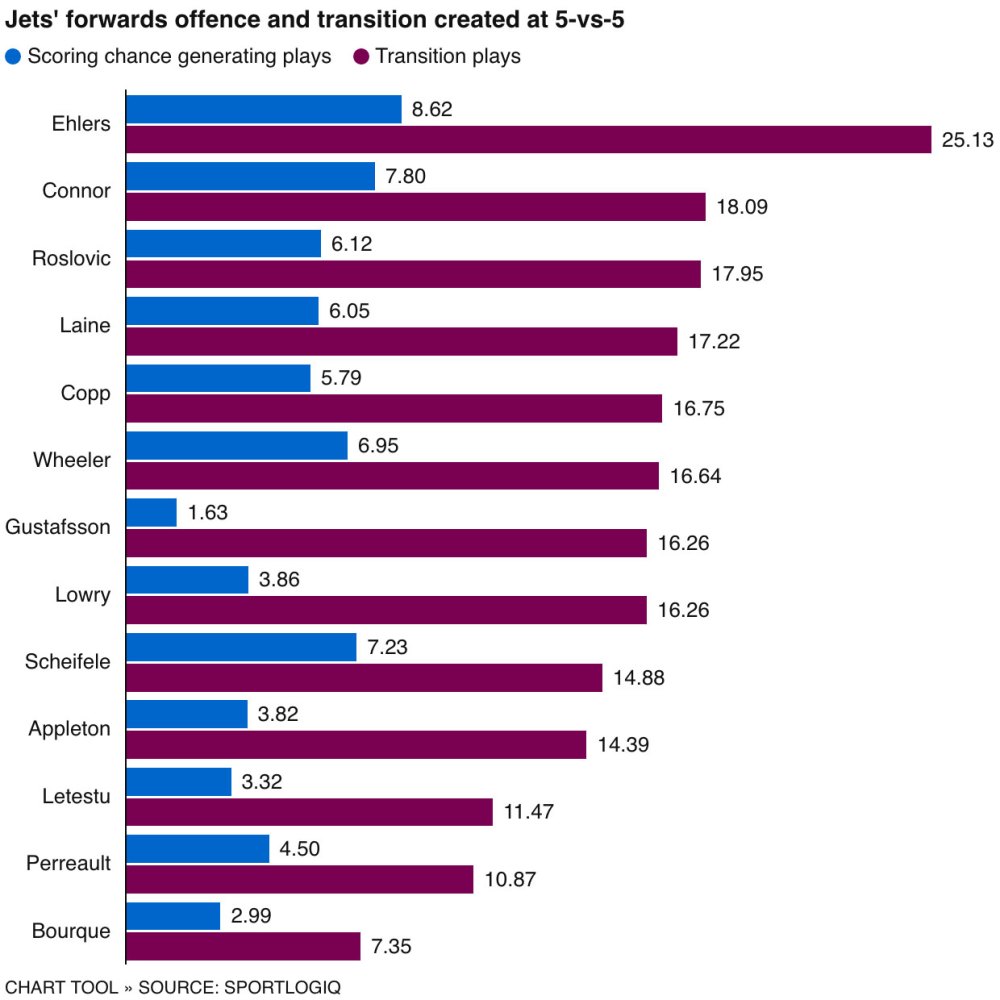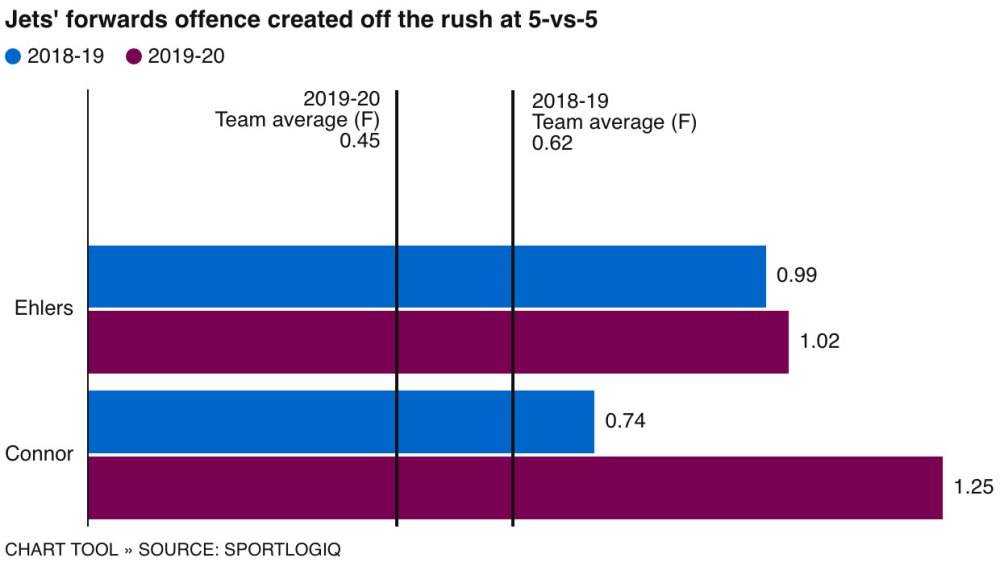High-flying Ehlers even more dangerous with Connor as linemate
Read this article for free:
or
Already have an account? Log in here »
To continue reading, please subscribe:
Monthly Digital Subscription
$0 for the first 4 weeks*
- Enjoy unlimited reading on winnipegfreepress.com
- Read the E-Edition, our digital replica newspaper
- Access News Break, our award-winning app
- Play interactive puzzles
*No charge for 4 weeks then price increases to the regular rate of $19.00 plus GST every four weeks. Offer available to new and qualified returning subscribers only. Cancel any time.
Monthly Digital Subscription
$4.75/week*
- Enjoy unlimited reading on winnipegfreepress.com
- Read the E-Edition, our digital replica newspaper
- Access News Break, our award-winning app
- Play interactive puzzles
*Billed as $19 plus GST every four weeks. Cancel any time.
To continue reading, please subscribe:
Add Free Press access to your Brandon Sun subscription for only an additional
$1 for the first 4 weeks*
*Your next subscription payment will increase by $1.00 and you will be charged $16.99 plus GST for four weeks. After four weeks, your payment will increase to $23.99 plus GST every four weeks.
Read unlimited articles for free today:
or
Already have an account? Log in here »
Hey there, time traveller!
This article was published 18/10/2019 (2243 days ago), so information in it may no longer be current.
One of the areas I kept revisiting last season when breaking down good things the Winnipeg Jets were doing was the play of Nikolaj Ehlers. From a point-production perspective, Ehlers had an underwhelming season in 2018-19 — scoring just 37 points in 62 games. His underlying offensive numbers, however, were excellent.
Specifically, he was one of only two Jets forwards — the other being Mark Scheifele — who was capable of competently attacking off the rush. This year, much of the same is occurring, with Ehlers being the driving force of the Jets’ rush attacks. Even more than that, he’s driving the team’s offence at even-strength overall and is the key to their ability to transition up the ice.
Ehlers is not only leading the Jets in plays that produce scoring chances, but blowing the entire forward group out of the water with his ability to transition the puck up the ice.
Every 20 minutes of ice time at even-strength, Ehlers is making a forward transition play 25 times, and no one else on the roster is even close. In fact, the closest forward to Ehlers in transition play is his linemate, Kyle Connor, which is not something that’s been a strength of his so far in his career. We’re going to touch on that momentarily.
Personal trainer's client list includes Winnipeg Jets Connor Hellebuyck and Laurent Brossoit

Posted:
Somewhere in the wilds of B.C.'s Okanagan Valley, just north of Kelowna, lives a man who never played the game.
Maybe the issue for the rest of the Jets’ roster is its transition play is built around defencemen. Carl Dahlstrom and Neal Pionk are both above 20 transition plays per 20 minutes and would be the next-best to Ehlers on the team, but once again, they’re not really anywhere close to his impact on the game.
Last season Ehlers was first in transition plays on the Jets and second in offensive involvement, so this isn’t new, but what is new is that he’s actually getting production out of it as well this year.
Eight points in nine games isn’t blowing the league apart offensively. It’s not Connor McDavid tying records set in the high-scoring 1980s kinds of offence, but it’s very good and sustainable production from Ehlers. When you factor in that he is also scoring on just 9.4 per cent of his shots on goal, and the Jets’ on-ice shooting percentage is just 7.78 per cent with him on the ice, his production so far is actually lower than what you would expect on average.
Ehlers may not be leading the Jets in points so far this season, but at even-strength it’s arguable that he’s been their best and most important player, aside from Josh Morrissey.
Another impact of Ehlers’ strong play this season has been his effect on Connor, who wasn’t a poor transition player last season, but has jumped up to be the second-best forward on the roster this season.
Ehlers is one of those players whose presence dictates the way a game flows while he’s on the ice because he’s so effective with the puck in all three zones. Last season Ehlers couldn’t really find a regular partner to ride shotgun with him on his rush attacks, which led to him producing a lot of offence off the rush but being on his own too often, making him easier to defend against.
This year, Connor has really bought into Ehlers’ style of play, and the underlying numbers are looking solid.
Ehlers is one of those players whose presence dictates the way a game flows while he’s on the ice because he’s so effective with the puck in all three zones.
Last year, Connor was better than team average at producing scoring chances off the rush, mostly by virtue of him being a high quality shooter overall and producing strong scoring-chance volume, but this year is another thing entirely.
Ehlers has improved slightly but mostly remained consistent; he appears to have found a partner who can work with his playmaking skills off the rush and convert more of his rush plays into goals.

Chances off the rush are the highest-quality chance type in the NHL, and when you add lateral passing to a teammate to the already dangerous proposition of an attacker coming in with speed, things get much more difficult for defenders to handle and for goaltenders to calculate what their best course of action is.
It’s very early in the season, so this duo may not prove to be as dangerous as the early numbers are leading us to believe, but if this is something that they can sustain, the Jets may finally have a second line that opponents struggle to deal with on a nightly basis, and the centre almost doesn’t matter.
If the Jets are able to weather the hits they’ve taken on the defensive end so far, I think this duo — and specifically Ehlers — will be a big reason why.
Andrew Berkshire is a hockey writer specializing in data-driven analysis of the game.

Andrew Berkshire
Andrew Berkshire is a hockey writer specializing in data-driven analysis of the game.
Our newsroom depends on a growing audience of readers to power our journalism. If you are not a paid reader, please consider becoming a subscriber.
Our newsroom depends on its audience of readers to power our journalism. Thank you for your support.













